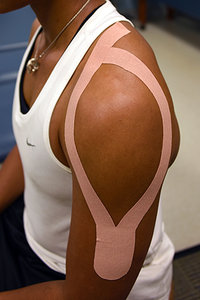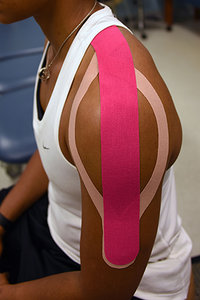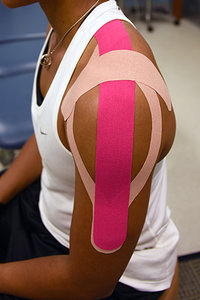Subacromial impingement syndrome (SIS) is a common musculoskeletal complaint treated by chiropractors. A common cause of pain, it is often aggravated by overhead motion.
A common course of SIS treatment is chiropractic care, including manipulation of the cervical and thoracic spine, as well as shoulder girdle manipulation. Additional exercise and other modalities also have been proven effective. Pekyavas and Baltaci (2016)1 in particular show that combination therapies are more effective than single-modality treatments.
Taping for SIS
 Figure 1
An additional modality that has become increasingly popular is kinesiological taping (KLT). Combined with other therapies, including manipulation, KLT is a valuable tool for SIS care within the chiropractic practice.
Figure 1
An additional modality that has become increasingly popular is kinesiological taping (KLT). Combined with other therapies, including manipulation, KLT is a valuable tool for SIS care within the chiropractic practice.
Since its introduction in the 1980s by Dr. Kenzo Kase, KLT has come a long way. Its usage skyrocketed after athletes used it during the 2008 Beijing Olympics. Today, it is an accepted modality for a variety of issues. There is some debate surrounding the treatment – doctors don't yet know whether it works through compression, providing support, enhancing lymph drainage, all of the above or perhaps through physiological effects. But the anecdotal evidence is convincing. However it works, KLT does bring patients immense relief.
Research Support
Although KLT has many applications, one common use is to apply it around the shoulder to provide symptomatic relief and to influence motor control. Recent studies support the use of KLT for shoulder pain, especially when combined with other modalities such as manipulation, laser therapy and exercise. The following is a brief synopsis of the research.
 Figure 2
A randomized, double-blind study by Simsek, et al. (2013),2 suggests a combination of KLT and exercise is more effective for SIS than exercise alone. A more recent study by Subasi, et al. (2016), compared KLT to subacromial injection. The study found that both interactions work, especially when combined with exercise, to improve visual analogue scale (VAS) scores for pain and range of motion (ROM), as well as shoulder pain and disability index (SPADI). The benefit of using KLT here is that, unlike the injection, it is non-invasive and carries no risk of infection.
Figure 2
A randomized, double-blind study by Simsek, et al. (2013),2 suggests a combination of KLT and exercise is more effective for SIS than exercise alone. A more recent study by Subasi, et al. (2016), compared KLT to subacromial injection. The study found that both interactions work, especially when combined with exercise, to improve visual analogue scale (VAS) scores for pain and range of motion (ROM), as well as shoulder pain and disability index (SPADI). The benefit of using KLT here is that, unlike the injection, it is non-invasive and carries no risk of infection.
A clinical effectiveness study by Shakeri, et al. (2013),3 used a randomized, double-blinded, placebo-controlled trial and showed that KLT produced an immediate improvement in pain intensity in nocturnal pain patients, but no significant improvement in ROM.
For patients at an early stage of SIS, Dong, et al. (2015),4 opined in a PRISMA systematic review that "exercise and other exercise-based therapies, such as kinesio taping, specific exercises, and acupuncture, are ideal treatments for patients."
 Figure 3
Finally, a randomized, controlled trial of rigid taping and KLT by Gulpinar, Ozer and Yesilyaprak (2017),5 showed that in the KLT group, glenohumeral internal rotation, total range of motion and posterior shoulder tightness all improved compared to the rigid taping group.
Figure 3
Finally, a randomized, controlled trial of rigid taping and KLT by Gulpinar, Ozer and Yesilyaprak (2017),5 showed that in the KLT group, glenohumeral internal rotation, total range of motion and posterior shoulder tightness all improved compared to the rigid taping group.
Based on this small sampling of recent research, KLT seems a useful addition to any clinician's care plan for SIS.
Applying the Tape
A general shoulder application of KLT can be easily derived thanks to the relative similarity of application processes from varied sources. In most reviewed applications, a total of three pieces of tape is suggested:
- The application of tape 1 involves a typical deltoid pattern, using a Y shape from the lower deltoid area and encompassing the deltoid muscle mass on both sides (Figure 1). Two separate pieces of tape may be used for this step.
- The second piece of tape should run in the opposite direction of tape 1, beginning at the upper trap area, extending down the center of the deltoid muscle and ending close to the elbow (Figure 2).
- For the final piece of tape, adhere a tape strip at the inferior angle of the scapula, with the tape continuing over the point of the shoulder and down into the pec area (Figure 3).
All of the tape strips are applied from their initial attachment point using very little stretch beyond what is built into the tape itself. The tape can remain for two to three days, and can be replaced as necessary depending on treatment plan and results.
Clinical Tips
Use the least amount of tape that is effective; choose a tape that adheres well, but causes little skin irritation; and make sure it is properly elastic to allow for the possible physiological effects. Several tape manufacturers meet these qualifications; trying different KLT manufacturers and methods will give clinicians the opportunity to learn specific tape qualities and techniques.
References
- Pekyavas NO, et al. Short-term effects of high-intensity laser therapy, manual therapy, and Kinesio taping in patients with subacromial impingement syndrome. Lasers Med Sci, 2016 Aug;31(6):1133-41.
- Simsek HH, et al. Does Kinesio taping in addition to exercise therapy improve the outcomes in subacromial impingement syndrome? A randomized, double-blind, controlled clinical trial. Acta Orthop Traumatol Turc, 2013;47(2):104-10.
- Shakeri H, et al. Therapeutic effect of Kinesio-taping on disability of arm, shoulder, and hand in patients with subacromial Impingement syndrome: a randomized clinical trial. J Nov Physiother, 2013;3:4.
- Dong W, et al. Treatments for shoulder impingement syndrome: a PRISMA systematic review and network meta-analysis. Medicine, 2015 Mar;94(10):e510.
- Gulpinar D, et al. Effects of rigid and Kinesio taping on shoulder rotation motions, posterior shoulder tightness, and posture in asymptomatic overhead athletes: a randomized controlled trial. J Sport Rehabil, 2017 Jul 17:1-26.
Dr. David Parish is the director of human performance at Logan University. He has extensive experience in chiropractic sports injury care and rehabilitation, including work as a team physician with professional, college and high-school sports teams. His experience also includes serving as a high-performance coach for the USA Para Powerlifting Team; and Team USA chiropractic physician for the ParaPan American Games, 2012 Paralympics Games and most recently, the 2016 Paralympic Games.




